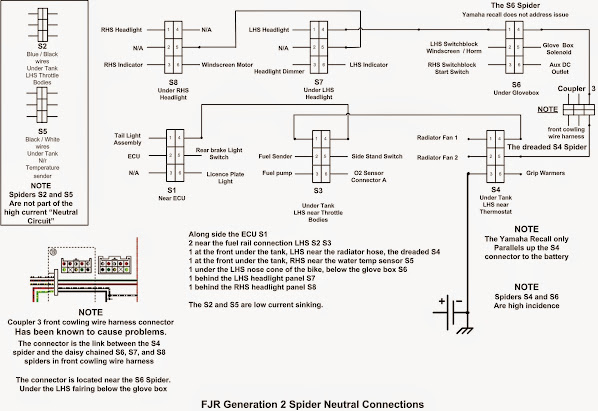bajaleo
Well-known member
Some of you may remember my problem of no headlights from a while back, as I received a lot of help from many of you.
https://www.fjrforum.com/forum//index.php/topic/161977-lost-the-headlights-this-morning-07-fjr/
Well it was barely a week after solving that issue that I was on my way to work and experienced a sudden high beam blue indicator light and both turn signal indicator lights blinking for just a moment. Classic ground spider failure symptoms from what I have read here.
Over the next 6 weeks or so, it only happened 3 times, and this past weekend I took about a 7 hour ride to the Rock Store on Mulholland with no problems.
Then yesterday I was riding home from work and made a couple of stops. After the first stop, the high beam indicator and both turn signal indicator lights were on solid, and when using the the turn signals they were blinking unusually fast.
After the second stop, I experienced a no start, along with the other symptoms. Fortunately there was a slight grade and I was able to bump start the bike and make it home.
My question is this: Did any of you who have been bitten by the spider(s) experience a no start along with the other problems? I don't seem to remember reading about it.
And yes, the first thing I checked last night was to make sure my battery terminals were tight.
Thanks, Leo
https://www.fjrforum.com/forum//index.php/topic/161977-lost-the-headlights-this-morning-07-fjr/
Well it was barely a week after solving that issue that I was on my way to work and experienced a sudden high beam blue indicator light and both turn signal indicator lights blinking for just a moment. Classic ground spider failure symptoms from what I have read here.
Over the next 6 weeks or so, it only happened 3 times, and this past weekend I took about a 7 hour ride to the Rock Store on Mulholland with no problems.
Then yesterday I was riding home from work and made a couple of stops. After the first stop, the high beam indicator and both turn signal indicator lights were on solid, and when using the the turn signals they were blinking unusually fast.
After the second stop, I experienced a no start, along with the other symptoms. Fortunately there was a slight grade and I was able to bump start the bike and make it home.
My question is this: Did any of you who have been bitten by the spider(s) experience a no start along with the other problems? I don't seem to remember reading about it.
And yes, the first thing I checked last night was to make sure my battery terminals were tight.
Thanks, Leo































































